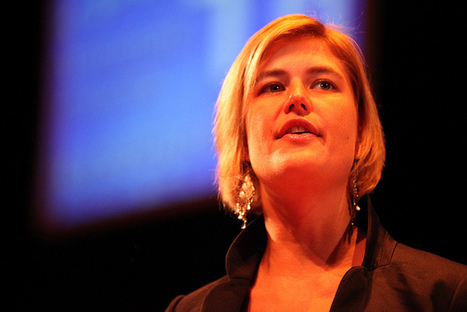 Your new post is loading...
 Your new post is loading...
The Forbes website, or "platform", as Lewis D'Vorkin, chief product officer for the media outlet, prefers to call it, publishes hundreds of articles a day, powered by not just its own journalists but a community of 1,300 contributors and a dozen brands producing "thought-leadership content".
Speaking at an event on Wednesday (30 October), held at the Telegraph, D'Vorkin discussed in detail the site's content strategy, which is based on the editorial pillars of "context, relevance and analysis".
Strikingly, it is seeing much success in resurfacing past content, with 50 per cent of its monthly traffic said to be to articles that are at least 30 days old.The "more quality content we produce, the more variety we produce, the more long-tail of content we have," he added.But the approach taken by Forbes demonstrates that it is not just a newsroom's own reporters who can achieve this....
As tech watchers debate the overuse of interactive tools in stories David Sarno says light interactive news stories don't go far enough. As a tech reporter at the Los Angeles Times David Sarno found himself frustrated that newspaper stories only engage “one lousy sense,” as he puts it. That would be sight.
Why couldn’t they be as interactive and entertaining as a video game like Grand Theft Auto, where a player can walk around a virtual city, drive a car, walk into a store (and, yes, kill people), and essentially have some control over a re-created reality?
Even when the iPad came out in 2010 (an event that Sarno prolifically covered for The Times) and made print media more touchable, Sarno wasn’t impressed. “At that time, and still largely today, what news organizations and magazines are doing is reproducing the print version on the screen,” he tells Fast Company. “It’s like two steps better than scanning in the print version and putting it on the iPad screen.”...
Innovative storytelling, audience engagement, and financial flexibility are key ingredients for newspapers to cope with pressures from competitors, budget constraints, and the speed at which technology is changing."It came as no surprise when The New York Times took home a Pulitzer for 'Snow Fall' - the immersive multimedia package impressed journalists and web designers alike with its seamless integration of text, audio, videos, photos and interactive graphics."The comments in "Trends in Newsrooms 2013," the World Editors Forum's report on the state of the news industry, about the attention-grabbing content, underlined the importance of stories that jump out at readers....
...as a group we tend to be arrogant, self-righteous and holier-than-thou (I include myself in this criticism). We tend to view ourselves as high priests of an exclusive profession and bearers of a special ethical standard that few others can live up to. We see ourselves as purer, more objective, less affected by the prejudices of the mere mortals we cover.
That is at least part of the reason we have trouble in the new world of entrepreneurial journalism, where journalists start and run their own news operations. If we want to go out on our own, we have to recognize for the first time that journalism is a business, that someone has to pay the bills and that there is money involved. Money? This is a dirty word for journalists. It makes us blush. We associate it with influence peddling, lobbyists, bribery, corruption and other topics of our investigative journalism.
Here are some other dirty words that entrepreneurial journalists who launch their own media will have to learn how to say without blushing...
...Up to 15 seconds of video, 13 custom filters, and a "cinema mode" for stabilization. Those were some of the features added to Instagram last week, instantly turning the popular photo-sharing app used by 130 million people into a video-sharing service. Within the first 24 hours of the announcement, over 5 million videos had been uploaded.Sure, some were of frothy lattes and the Miami Heat winning the NBA finals, but the new features have wider appeal than to just casual users.
As newsrooms are now relying on social media as a platform to discover and deliver the news, Instagram's new video features will add another piece of content into the mix for organizations: short, solid-looking video clips.Beth Bennett, assistant professor at The Medill School of Journalism, Media, Integrated Marketing Communications at Northwestern University, believes this will be the next big thing for news organizations....
The best thinking about journalism’s future benefits from its being in touch with technology’s potential. But it can get in its own way when it simplifies and repudiates the intelligence of journalism’s past.
That is happening, to a degree, in a discussion gaining momentum lately that journalism should now largely move beyond fact gathering and toward synthesis and interpretation.
The NSA story is just the latest case that shows the importance, and the elusiveness, of simply knowing what has really happened.
In a Nieman Journalism Lab post, Jonathan Stray made the case recently for moving beyond facts, or what might be called The Displacement Theory of Journalism. “The Internet has solved the basic distribution of event-based facts in a variety of ways; no one needs a news organization to know what the White House is saying when all press briefings are posted on YouTube. What we do need is someone to tell us what it means.”...
Twitter is a frenemy," said Jeff Zucker, CNN's new president, as reported by MediaShift. Jeff Zucker was describing the cable news network's relationship with social media and added, “the network uses, relies on -- and is scared by -- social media.” Twitter had a marquee moment last week, particularly late Friday afternoon and evening, that should scare most television news outlets in the business of reporting breaking news. That’s when Boston Marathon bombing suspect Dzhokhar Tsarnaev was cornered by police, trapped and almost bleeding to death inside a covered boat in a backyard in Watertown, Mass....
Pew found that just over a quarter (27%) of adults say they regularly or sometimes get news or news headlines through Facebook, Twitter or other social networking sites. This rises to 38% for younger adults....
|
Amazon CEO Jeff Bezos says he sees a future in which newspapers are like horses — a luxury item for a small group of people, not a mainstream transportation method — but his analogy is both right and wrong.
The New York Times Company did the world of journalism a big favor today.The company finally disclosed the exact revenues of its digital business.The numbers were impressive. And they made clear that no one ever needs to fret about the future of journalism again.Specifically, the New York Times reported that the revenue of its digital business is now about $360 million a year....
Does this signal the beginning of the end for Forbes as a knowledgeable source of business information? Have they finally "jumped the shark" on their way to the exit? "Jumping the shark" is actually an expression that goes back to the TV sitcom series, Happy Days. It was a show that pictured everything as rosy and happy, with neat little endings that were all nicely tied up in twenty-two minutes. The chief influencers on that show were "The Fonz," who only had to give you a look to let you know you were in trouble, and Mr. Cunningham, who set down the rules of the family.
In the midst of its ten-year run the writers must have gotten tired or were negatively influenced by the Hollywood decision-makers, when they inexplicably decided to have their characters travel to Los Angeles. Well, one thing leads to another and Fonzie ends up responding to an assault on his courage by taking to water skis (wearing his leather jacket of course) and jumping over a shark.
The stunt was so ridiculous and out of character that "jumping the shark" eventually came to be known as the moment when a television show begins a decline that is beyond recovery. While Happy Days bravely soldiered on for a few more years, it was never really the same in the minds of viewers and critics. Since that time the meaning has been broadened to define the moment when a brand or creative effort begins to lose the qualities that initially defined its success. Some still refer to "New Coke" as the moment when the Coca-Cola Company jumped the shark....
Handheld devices such as mobile phones and tablets are on track to become the dominant platforms for news consumption, and more people are using more than one device, a survey of media consumption habits in nine countries has found.
“News is becoming more mobile, more social, and more real-time,” according to the recently released Reuters Institute Digital News Report 2013: “Tracking the Future of News,” an annual survey which monitors the transition to digital media. “The overwhelming message is that audiences increasingly expect news that they can access anytime, anywhere."
While the survey found the computer remains the primary device for accessing digital news, a third of respondents reported getting news on at least two devices, and 9 percent said they use more than three. Tablet usage doubled in the 10 months since the last survey....
Traditional journalists probably won't like a lot of how Upworthy's become one of the fastest growing aggregators on the web. But it's hard to question the effectiveness of its methods.
Back in November, the Lab’s own Adrienne LaFrance wrote a number of words about Upworthy, a social packaging and not-quite-news site that has become remarkably successful at making “meaningful content” go viral. She delved into their obsession with testing headlines, their commitment to things that matter, their aggressive pushes across social media, and their commitment to finding stories with emotional resonance.
Things have continued to go well for Upworthy — they’re up to 10 million monthly uniques from 7.5. At the Personal Democracy Forum in New York, editorial director Sara Critchfield shared what she sees as Upworthy’s secret sauce for shareability, namely, seeking out content that generates a significant emotional response from both the reader and the writer....
BuzzFeed gets free content, users get exposure, we get 11 Engagement Photos That Will Make You Happy You’re Single. ... The department devoted to creating this “old school” content is known as BuzzTeam. Their focus is anything shareable — lists, animals, nostalgia. The kind of content that BuzzFeed’s loyal readers have become hyper-familiar with. Many, in fact, have consumed so many such BuzzFeed posts that they’ve become adept at mimicking both their tone and their viral success. Earlier this month, BuzzFeed’s editors took a step toward giving those faithful followers a little more of the spotlight they crave. Shepherd, along with a staff of four, now run BuzzFeed Community, a content-producing vertical of its very own, complete with featured posts by community members and a leaderboard with the latest on who’s posts are getting the most traffic, likes, comments, and badges. It’s a competitive place, and anyone can join and enter the fray....
...and "the editing process is zero, pretty much."... Great insight into the speed of online publishing.
If journalists don’t stand up to take ownership of this exciting new medium and build great things on it, the engineers and the MBAs will. In the news businesses that will emerge, journalists will continue to remain at the bottom of the Excel sheet of layoff-ability. That is indeed what has been happening, when a lawyer builds the web’s most important technology news site (Michael Arrington – Techcrunch) or two engineers build the most exciting magazine App for tablets and phones (Flipboard). A former equity research analyst edits one of the most popular business news websites (Henry Blodget – Businessinsider). Journalists of the traditional mould don’t quite dictate things in these companies....
|



 Your new post is loading...
Your new post is loading...























Chief product officer Lewis D'Vorkin outlines the business news outlet's approach online, where 50 per cent of its monthly traffic is to articles at least 30 days old.